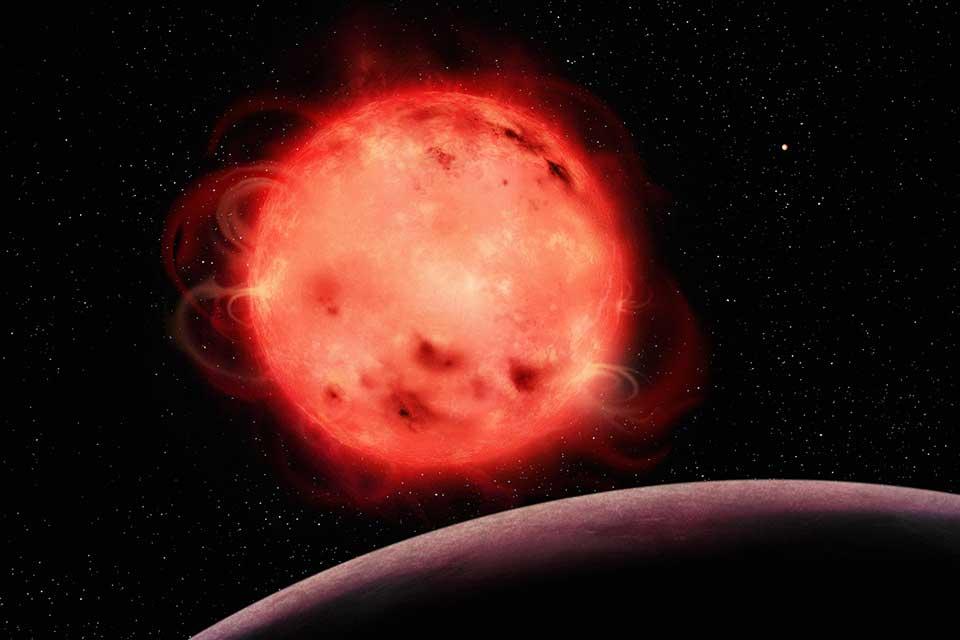Dr Jake Taylor from the Department of Physics at the University of Oxford is one of a team of scientists led by the Université de Montréal to analyse data from the James Webb Space Telescope (JWST) of the TRAPPIST-1 exoplanetary system. The research sheds light on the nature of TRAPPIST-1 b, the exoplanet orbiting closest to the system’s star and also shows the importance of parent stars when studying exoplanets.
TRAPPIST-1 is a nearby system consisting of seven rocky, Earth-sized exoplanets transiting a M8V-type star, ideally suited to in-depth studies of small, temperate exoplanets. This is the first spectroscopic observation of any of the TRAPPIST-1 planets obtained using JWST’s near infrared imager and slitless spectrograph (NIRISS).
Secondary atmospheres
Each TRAPPIST-1 planet has previously been observed both from space and from the ground, and these data confidently rejected cloud-free, hydrogen-rich atmospheres; yet, the observations could not constrain the presence of secondary atmospheres, whose detection requires higher instrumental precision. The group were interested in these secondary atmospheres, as these are similar to the one that exists around Earth – not formed through the accretion of gases during the period when the star formed.
In a paper published in The Astrophysical Journal Letters, the group present the first transmission spectra of TRAPPIST-1 b with NIRISS in single object slitless spectroscopy (SOSS) mode. In order to study the transmission spectrum of the exoplanet, the team observed the planet as it passed in front of its host star on two different occasions. NIRISS/SOSS is one of the key observing modes for studying exoplanet atmospheres, it can measure the light passing through the atmosphere of an exoplanet between 0.6 and 2.8 microns, thus spanning part of the optical and part of the infrared. With these two transit observations, the group is able to confirm the absence of cloud-free, hydrogen-rich atmospheres, but cannot assess the presence of secondary atmospheres.
Stellar contamination
Secondary atmospheres are difficult to probe as they produce small observable spectral features. In the study, the team calculate that a secondary atmosphere around TRAPPIST-1 b would have spectral features in the range of 100 to 200 ppm; the median precision achieved on the data is 83ppm, thus below the predicted precision needed. Despite this, it was not possible to rule out a range of different secondary atmospheres, instead it was found that the transmission spectrum was heavily influenced by contamination from the star. This contamination includes: star spots, faculae and stellar flares.
While demonstrating the capability of NIRISS/SOSS to achieve sensitivity to secondary atmospheres on Earth-sized exoplanets orbiting late-type stars, the results highlight the challenge of stellar contamination for transmission spectra. The group’s work highlights an important caveat for future explorations, which calls for additional observations to characterise stellar heterogeneities empirically and/or theoretical works to improve model fidelity for such cool stars.
Precision instrument
‘Transmission spectroscopy serves as our best technique to study secondary atmospheres around cold terrestrial planets and we show that JWST is more than capable of reaching the precision needed,’ comments Dr Taylor. ‘The challenge we found in this study is the physical processes of the host star can hamper our interpretation of the atmosphere, as these cooler stars have their own spectral features. This is important to understand, as transmission spectroscopy is currently the only technique we can use to study the planets in the habitable zone of this system. We must study the star in more detail, our study paves way for more detailed stellar characterisation.’
Atmospheric reconnaissance of TRAPPIST-1 b with JWST/NIRISS: evidence for strong stellar contamination in the transmission spectra, O Lim et al, The Astrophysical Journal Letters, 22 September 2023

